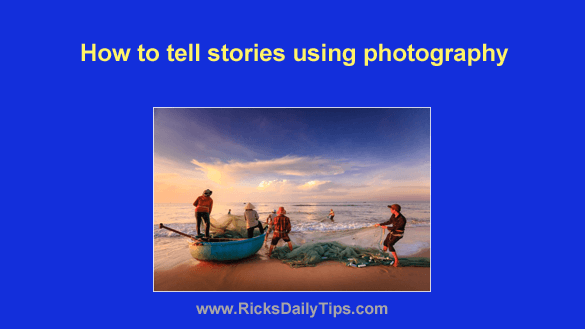 Want to get my easy to follow Tech Tips in your email?
Want to get my easy to follow Tech Tips in your email?
Sign up for my daily Rick’s Tech Tips Newsletter!
Note: The links in this post are affiliate links.
Storytelling is usually at the heart of any great piece of art, and this is especially true with photography, an art form in which storytelling can evoke a wide range of emotions in your audience.
You might wonder exactly what storytelling in photography entails, and why photographs that tell stories are different to those produced by traditional photographic methods.
Truth be told, a well-composed and well-captured photograph is one of the most powerful tools one can use to convey a message to the viewer, and countless books have been written explaining exactly how to capture great photos.
Simply put, visual, written and spoken stories all stimulate an essential aspect of the human mind: our imagination.
When somebody tells you a story, they recount events that have transpired by using words to enable you to imagine how the situation unfolded. The story itself gives you a framework to worth with, but by using your imagination, you are also combining the story with your own beliefs and experiences.
This means that every story is unique in the minds of its beholders. Stories aren’t just a basic recollection of events that have taken place. They are a powerful conduit through which we can recall our own experiences, use our imaginations, and develop our understanding of the world as we know it.
It’s our own imagination that gives the story emotional meaning, and it’s the story that empowers us to feel those emotions.
No two interpretations of a story will ever be exactly the same, and it’s the photographer’s job to provide a message or story to the viewer that guides the viewer to create their own perceptions of their visual artworks.
Take this photo for example:

Are these fishermen casting their nets for fun or profit? The answer is almost certainly for profit, but the answer could be quite different for people who love to fish.
What Makes a Story Successful?
Successful stories are those that can invoke emotion and convey meaningful messages to their listeners. In a photographic context, traditional photography can be redefined through the art of storytelling to form deeper, more thought-provoking emotional connections with an audience.
There are two main ways to tell stories through photographs: by telling them using single images, and by telling them using a series of images.
Single-Image Stories
Single images rely on insinuated stories to capture audiences’ attention effectively.
Single photographs present stories that are left open to interpretation, allowing the viewer to create and complete the story themselves, guided by their own imagination and personal experiences.
There is no setup or traditional story progression in a single image. Photographers instead use strong visual and emotional cues and symbols to steer viewers towards a specific path of emotion and comprehension.
Creative use of visual language, such as using widely recognized symbols or leading lines to show viewers which parts of an image to focus on, can be helpful in telling visual stories.
For example, a red rose symbolizes love, romance and passion…

While a white dove is usually interpreted as a symbol of peace or forgiveness…
 It’s through the strategic combination of these visual language elements that photographers can guide their viewers to understand their work on emotional and cerebral levels.
It’s through the strategic combination of these visual language elements that photographers can guide their viewers to understand their work on emotional and cerebral levels.
Viewers that can form an emotional connection with a photograph will usually be more compelled by its message, an effect which could make your photography work more memorable as well.
Multiple Image Stories
You can use collections or a series of great photographs to tell a story to an audience through the use of a narrative arc.
Every engaging story has a captivating introduction, body and conclusion, and a photographer’s job is to figure out how best to show this narrative arc from start to finish through a series of visual works.
There are plenty of different, classic story arcs to draw inspiration from when telling stories through multiple image series. You can depict a character’s journey, the progression of a relationship, or the milestones of a life well lived.
Telling a story through a photographic series could even be as simple as using three images as an introduction, climax, and a resolution.
For example, if you wanted to tell your viewers a story about a family’s move from one home to another, you could take an image of them standing outside their old home, bags and boxes in tow, a second image of navigation in their car on the way to their new town, and a final shot of them smiling on the porch of their new home.
There are endless ideas and possibilities to explore. It’s important to remember not every photograph needs to tell a deliberate tale. You can create a portfolio of diverse images, all of which show contrasting situations or unrelated topics.
Photographers don’t necessarily need to tell a story with every shot they take, but that won’t stop their audience from imagining one anyway.
What this means is that you don’t need to spend hours planning the purpose and meaning of every single shot you take and print.
Even the simplest aspects of daily life can tell tales of their own when captured skillfully, and because humans are hard-wired for storytelling, your audience will recreate the stories of these images in their own ways.
Open and Closed Stories
Your photographs can either convey a complete story, from start to finish, or leave a few clues for your viewers to interpret.
Closed stories, which are usually portrayed in multiple images, provide a concrete resolution.
Open stories, often portrayed by single images, don’t make the whole story obvious, giving a viewer the chance to fill in the blanks themselves.
For example, what are the circumstances behind this masked young woman and child standing in the middle of a road?

As you might imagine, the answer will likely be different for every person who happens to see it.
Open stories are often more engaging for viewers, as they give them an opportunity to have a more direct and personal influence on the stories’ outcomes.
They also demand more imaginative interpretation, which can hold viewers’ attention for longer and create mixed and sometimes even polarizing interpretations of your work.
Not everyone will understand your artistic efforts or be able to create a story from your visual cues, but some of your viewers will appreciate the hints that your photographs provided to allow them to come to the comprehension of your story they have reached.
Bottom line
Telling stories through photography is an exercise in imagination and in emotional connection. Your viewers will need to use their imaginations to create and flesh out the stories you tell, just as you will need to use yours to convey them using emotive and symbolic visual language.
Storytelling in photography should always start with an intriguing character, item or detail that immediately catches the attention of your viewer.
Your aim should be to direct them through a narrative towards an unexpected twist that leads to tension and a grand resolution or denouement.
Photographs can depict simple, linear stories that are obvious to the viewer, but they also have the power to tell much more complex tales.
Your images should use abstract visual aids to prompt your audience to make connections between your work and their experiences, memories, beliefs and feelings to tell a story that they will remember.